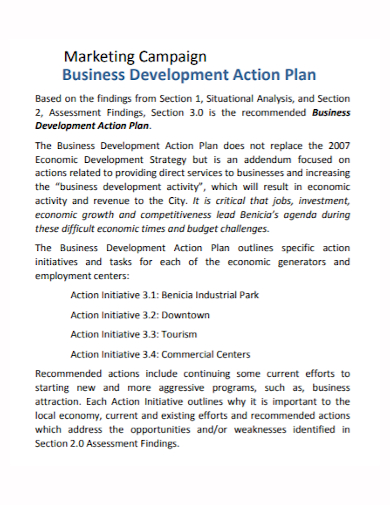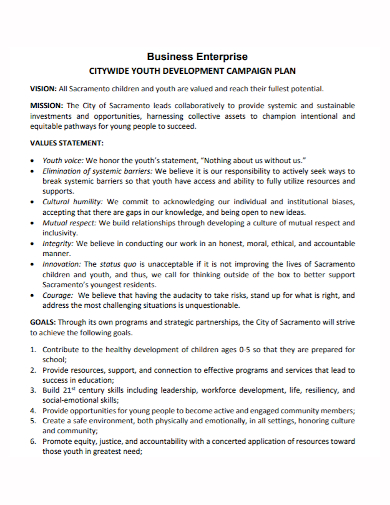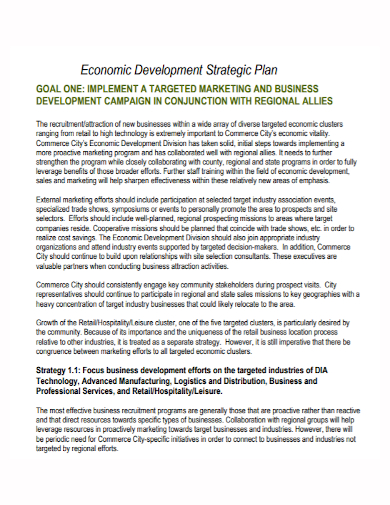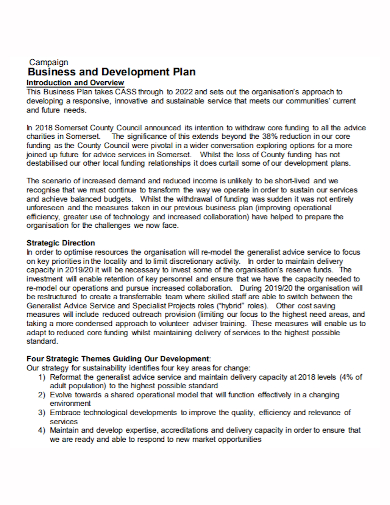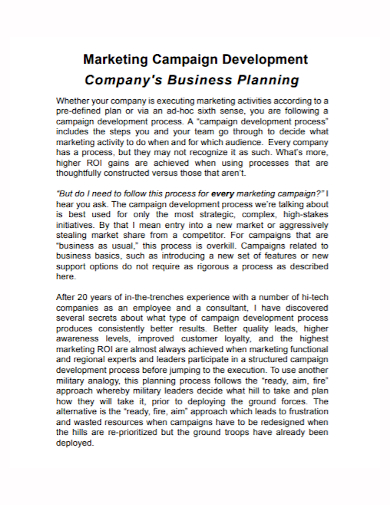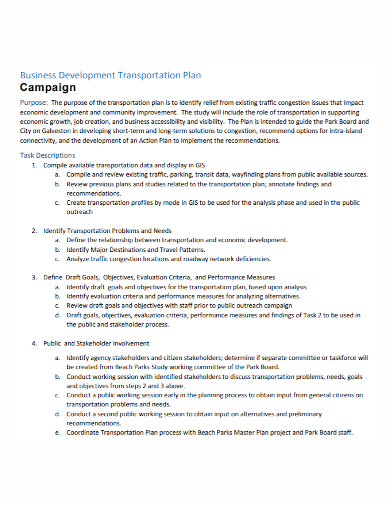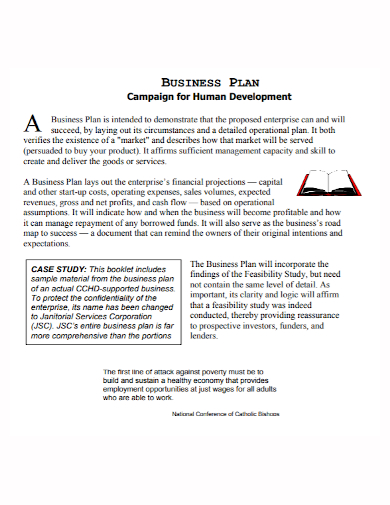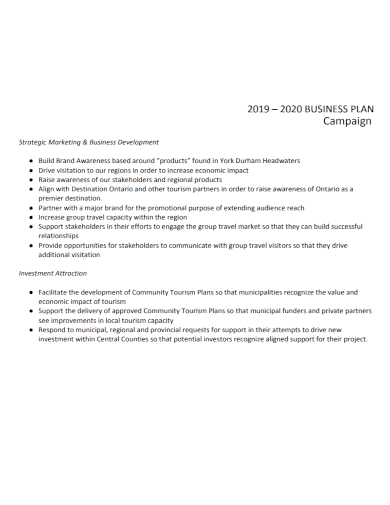As a business owner, you obviously want to expand your business and increase your network. But the question is, how to get started on it? It’s simple. A business development plan is the first step you need to take. A business development plan is much more than a piece of document. It is what defines your current positioning and helps you devise and implement a strategic plan. That, in turn, doesn’t just bring in sales, but also goodwill and long-term relations with your stakeholders. Having a business development plan is like living a healthy lifestyle – it will only offer great things in return but it does demand a little effort and time. Whereas, a business with no such plan is bound to misplace time, energy and suppress its growth. This article will guide you on how to make a business development plan.
9+ Business Development Campaign Plan Samples
1. Business Development Campaign Plan Template
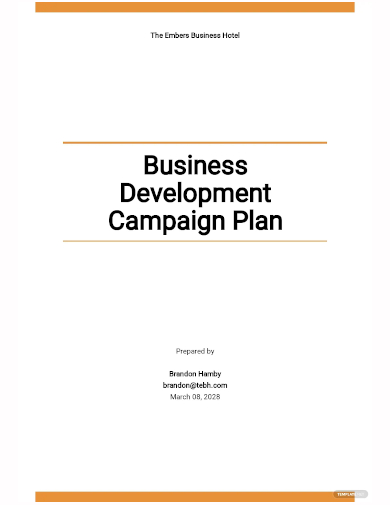
2. Business Development Campaign Action Plan
3. Business Enterprise Development Campaign Plan
4. Business Development Strategic Campaign Plan
5. Business Development Political Campaign Plan
6. Sample Business Development Campaign Plan
7. Business Development Marketing Campaign Plan
8. Business Development Campaign Transportation Plan
9. Business Campaign Human Development Plan
10. Business Investment Development Campaign Plan
What is a Business Development Plan?
A business development plan is a detailed strategic plan on how to develop your business by implementing various ideas, tactics, and strategies that assist a company in scale better in every sphere of the business. It is a guide to bring everyone in the organization on the same page and get them to work towards a common goal.
How to Make a Business Development Plan
1. Know Your Goals
You need to have a clear idea of what success will look like. This will help you to manage your own and others’ expectations. If you set measurable goals at the outset, it will be easier for you to select the right activities to help you achieve these aims as well as set up systems to enable you to measure progress and results.
2. Know Your Target Market
Sometimes there is a lack of clarity over the target market. Sometimes the chosen target market is too broad. Once you have identified your target market, you can identify the relevant channels to reach them – whether these are predominantly through traditional means or online and digital methods.
3. Know Your Target’s Needs
The best campaigns are based on a deep insight into the current or future needs of your target market. If you can identify a need that is currently not served by existing providers then it will be easier to develop your proposition and your campaign. It might mean that your campaign has an initial product or service development aspect where your creativity and innovation skills are required.
4. Define Your Proposition
Developing a value proposition that differentiates you from the competition is a challenge. Rather than thinking about promoting all of your products or services, identify a specific proposition that meets the needs of a specific target market in a particular situation. You may need to package up different elements of technical expertise with service delivery and relationship management facets to create a compelling proposition.
5. Define Your Overall Strategy
It is unlikely that you will be working alone and in isolation so you will need to align and integrate your campaign with those in your firm – at the overall brand level and in different practice groups and offices. It also means that each individual can play to their individual strengths as part of the overall campaign effort. If you are primarily seeking new clients then you will need a different approach. You may decide to approach them directly – through advertising, media relations, digital marketing or personal selling or you may decide to approach them indirectly – for example, through third-party intermediaries or other referrers. You may decide to adopt a push strategy – reaching out to people with specific communications. This would be the case if you are focusing on personal selling. You will also need to decide whether you want to achieve your aims through high volumes of work or lower volumes of high-value work. And your service delivery and pricing strategies will be important here.
6. Know Your Content Strategy
When there is clarity over what you are trying to say and to whom, you can turn your thoughts to your content management strategy. This is where you consider what knowledge or material you will provide – over a period of time – that positions you in your chosen market, raises your profile and generates interest, interaction, and inquiries. Your content strategy will consider how you extract specific topics that can be used on a monthly, weekly and daily basis to communicate through different channels.
7. Define Your Media Strategy
With ideas about what content you will have, you can consider the best ways to share the content with your target market. You may choose a predominantly digital strategy where you develop a special area of your web site, manage pages and accounts in social media, and an internal database from which to send email communications. Alternatively, you might identify key associations or communities or groups where you need to have a personal presence – this may involve presenting papers at key conferences, collaborating with other bodies to present seminars or attending events where you can network. Ideally, there should be a blend of these different channels and methods so that you raise your awareness in a market before you get face-to-face with people.
8. Create Your Plan
All of these decisions can then be crafted into a plan. You can then use this plan – showing what you hope to achieve and what you will do to make it happen – to secure the necessary resources from your management team. The plan needs to show the start and completion time of each activity as there are usually some critical paths. Some activities may need a significant lead time – for example, you will likely need to provide at least four weeks’ notice to get people to attend a seminar.
FAQs
What are the benefits of a business development campaign?
- Helps a Business Boost Sales
-
Presents Expansion Opportunities
-
A Better Understanding of your Consumer
-
Improves Company Image
What are good business development strategies that could be implemented?
- Understand your competitive landscape.
- Choose effective KPIs.
- Develop long-term customer relationships.
- Implement customer feedback.
- Keep your website content and user interface fresh.
- Speed up your response time.
- Leverage a sales plan to identify areas of growth.
- Implement a social listening strategy.
- Sponsor industry organizations, conferences, and events.
Once your campaign plan is produced, the hard work really starts! You need to find the time and motivation to drive its implementation. And it is an ongoing process so the stop-start approach of the typical fee-earning professional is unlikely to be successful. The best campaigns are those that have sustained activity over a lengthy period of time. But the beauty of having a campaign plan is that you know in advance what needs to be done and there is a route-map of bite-sized business development activity already mapped out for you! To help you get started making the plan, download our free sample templates above to use as your guide!
Related Posts
FREE 7+ Fashion Business Plan Samples in PDF
FREE 10+ Sprint Planning Samples In MS Word | Google Docs | PDF
FREE 10+ Wedding Planning Samples in MS Word | Apple Pages | Powerpoint | PDF
FREE 9+ Monthly Study Planner Samples in PSD | Illustrator | InDesign | PDF
FREE 9+ Sample Curriculum Planning Templates in PDF | MS Word
FREE 10+ Teacher Development Plan Samples in MS Word | Google Docs | Apple Pages | PDF
FREE 10+ Basketball Practice Plan Samples in PDF
FREE 12+ School Business Plan Samples in PDF | MS Word | Apple Pages | Google Docs
FREE 7+ Client Strategic Plan Samples in PDF | MS Word
FREE 11+ Trucking Business Plan Templates in PDF | MS Word | Google Docs | Pages
FREE 7+ Small Hotel Business Plan Samples PDF | MS Word | Apple Pages | Google Docs
FREE 14+ Bakery Business Plans in MS Word | PDF | Google Docs | Pages
FREE 4+ Yearly Lesson Plan Samples in PDF
FREE 50+ Strategic Planning Samples in Google Docs | Pages | PDF | MS Word
FREE 10+ Construction Project Plan Samples in MS Word | Google Docs | Apple Pages | PDF

